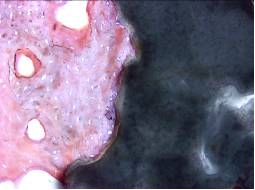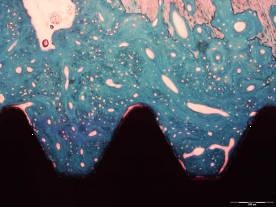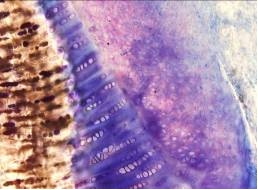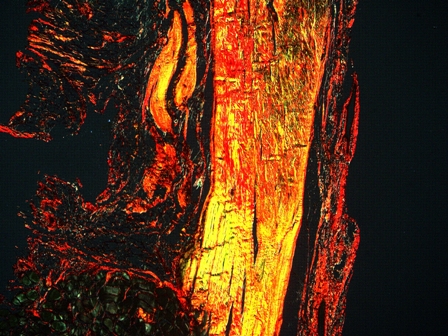For each research a study protocol is set up that provides analysis of scientific background (i.e. state of the art, epidemiology, physiology and pathophysiology, current treatments), feasibility, operating procedures, critical issues and, depending on the features, the protocol is presented to the Scientific Direction. Subsequent to any approval by the Ethical Committee (CE-AVEC), if required by law, the research protocol is sent to the competent authorities. The experimental model more appropriate for the type of research is selected according to specific standards of reference, to pathophysiological and biological characteristics, the knowledge available in the literature. As examples of studies, we report some studies of bone, cartilage, tendons and ligaments.
 In the context of bone tissue, techniques for the repair and regeneration of loss of substance, fractures, nonunions and pseudoarthrosis are valued. For the treatment of these injuries biological and synthetic biomaterials are studied, associated and not to mesenchymal stem cells and / or growth factors and other techniques for tissue regeneration. To study the osteogenic properties of biomaterials and innovative techniques at different experimental times radiographic histological, histomorphometric and biomechanical studies are performed.
In the context of bone tissue, techniques for the repair and regeneration of loss of substance, fractures, nonunions and pseudoarthrosis are valued. For the treatment of these injuries biological and synthetic biomaterials are studied, associated and not to mesenchymal stem cells and / or growth factors and other techniques for tissue regeneration. To study the osteogenic properties of biomaterials and innovative techniques at different experimental times radiographic histological, histomorphometric and biomechanical studies are performed.
 To evaluate the properties of biomaterials and their chemical and topographical surface modifications in accelerating and improving the process of otseointegration, nails, screws, chips and joint prostheses are studied. At established experimental times, the degree of mechanical and biological osteointegration is evaluated through torsion tests, push-outs, pull-out, microhardness, histology, static and dynamic histomorphometry, computed microtomography. In association with the implant itself, adjuvant therapies are tested to evaluate the possible improvement of the endogenous regeneration of bone around the implant which can be impaired in patients regardless of the properties of implanted biomaterials.
To evaluate the properties of biomaterials and their chemical and topographical surface modifications in accelerating and improving the process of otseointegration, nails, screws, chips and joint prostheses are studied. At established experimental times, the degree of mechanical and biological osteointegration is evaluated through torsion tests, push-outs, pull-out, microhardness, histology, static and dynamic histomorphometry, computed microtomography. In association with the implant itself, adjuvant therapies are tested to evaluate the possible improvement of the endogenous regeneration of bone around the implant which can be impaired in patients regardless of the properties of implanted biomaterials.
These researchers aim to the development of new materials and surgical techniques that can stimulate the process of osteointegration and reduce the aseptic failure of implants and are also performed considering the presence of diseases that cause a decline in bone mineral content such as the postmenopausal osteoporosis.
Experimental models of osteoporosis can better simulate the clinical situation of many patients undergoing implantation, which have osteoporosis by age, menopause or due to incorrect lifestyles or other systemic diseases and their treatments. This makes search results more reliable and with a higher probability of clinical transfer.
 Models for studying the treatment of osteoarthritis are used to evaluate different methods of chondroprotection, biomaterials and biological and synthetic scaffolds also in combination with differentiated and not differentiated cells.
Models for studying the treatment of osteoarthritis are used to evaluate different methods of chondroprotection, biomaterials and biological and synthetic scaffolds also in combination with differentiated and not differentiated cells.
The characteristics of joint tissue are evaluated with histological, immunohistochemical and histomorphometric analyses and with the adoption of particular histomorphometric "scores". Analysis on the synovial fluid allows us to study the inflammatory response and other disorders related to joint diseases through the study of growth factors, cytokines and activity of synoviocytes isolated and cultured in vitro.
Still in the field of cartilage tissue, the study of acute surgical chondral and osteochondral injury allows to evaluate different therapeutic methods such as the osteochondral graft, microfractures and other techniques of tissue engineering using various types of biomaterials as scaffold associated with mesenchymal stem cells or autologous chondrocytes previously expanded in vitro or for one step in situ tissue engineering. Again histomorphometric measures and adequate "scores" allow the study of the joint surface (including subchondral bone).
 Acute and chronic injuries of tendons and ligaments are studied, with particular reference to rotator cuff massive lesions, traumatic lesions of the anterior cruciate ligament and meniscus, chronic tendon injuries and related pathological processes in function of lifestyles such as sedentary or active life. Tenocytes, cells from ligaments and tissues are studied, through the analysis of metabolic and proliferative cellular activity, the morphology and biomechanical characteristics of tissues. Therapy and scaffolds of biological and synthetic origin are studied for the treatment of traumatic and degenerative injuries and for the regeneration/ replacement of tissues.
Acute and chronic injuries of tendons and ligaments are studied, with particular reference to rotator cuff massive lesions, traumatic lesions of the anterior cruciate ligament and meniscus, chronic tendon injuries and related pathological processes in function of lifestyles such as sedentary or active life. Tenocytes, cells from ligaments and tissues are studied, through the analysis of metabolic and proliferative cellular activity, the morphology and biomechanical characteristics of tissues. Therapy and scaffolds of biological and synthetic origin are studied for the treatment of traumatic and degenerative injuries and for the regeneration/ replacement of tissues.
